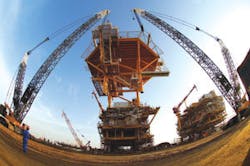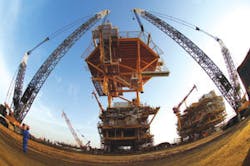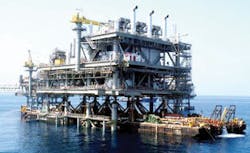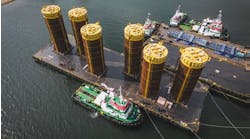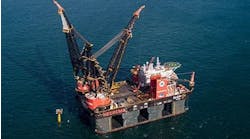Jeremy Beckman, Editor, Europe
Global gas demand is spurring a series of new developments on Qatar’s giant North field. Much of the resulting production will be converted to LNG at the expanding network of process complexes in Ras Laffan Industrial City.
The surge in activity has also benefited the Dubai yard of J. Ray McDermott in the form of contracts from Dolphin Energy, RasGas, and Qatargas. The workload comprises a wide range of shallow-water platform and subsea structures. Saudi Aramco has maintained the momentum with two recent orders for a large consignment of jackets for its Maintain Potential project.
Engineering upgrades
J. Ray’s facility and associated marine base is located in the Dubai port of Jebel Ali Free Zone. The fabrication area extends across 58.6 ha, with a total quayside length of 1,038 m. Of this, 346 m has been reinforced to allow load-out of structures weighing up to 14,000 metric tons. Minimum water depth at the quayside is 11.5 m.
Tonnage capacity at the site is 50,000 million tons/yr, with a productivity capability exceeding 5 million man-hours. This year the yard is undergoing a series of upgrades, mainly in the form of new equipment and cranes; further investments are planned in the marine base.
Helideck trial fit on Dolphin Energy’s platforms in Jebel Ali.
Recent engineering improvements include the purchase of Aveva’s Vantage Enterprise (VNET) software suite. J. Ray, which was already using Aveva’s PDMS tools, invested in VNET partly to ease execution of engineering, procurement, installation and construction (EPIC) projects. It also sought to improve handover of final documents such as 3D design models.
The software has widened information access to all members of J. Ray’s project teams, allowing them to follow developments more easily via the Internet. Construction personnel can now also access the 3D design model database from satellite field offices, allowing them to react immediately to planned status changes. This in turn helps staff assess priorities earlier in a project’s life-cycle.
Jebel Ali does not typically sub-contract work, either to J. Ray in Louisiana, or to smaller fabricators in the Middle East. On occasion, however, it will sub-contract specialists locally for architectural and heating/ventilation/air-conditioning work, application of special coatings, or chemical cleaning techniques.
If needed, J. Ray in Houston can also contribute expertise in, for instance, health, safety and environmental studies. Although the Houston office has more wide-ranging experience in front-end design and conceptual engineering, in general, Jebel Ali can handle most jacket, topsides, and pipeline design requirements in-house. It can also support the Houston office during periods of high activity.
For offshore construction and installations, J Ray’sDB 27 derrick/pipelay vessel provides one of the largest heavy-lift capabilities in the Middle East, with an onboard crane capacity of 2,400 tons. In pipelay mode, the vessel can install pipelines up to 72-in, diameter in S-lay mode. During peak periods, the contractor can bring in other vessels from its global fleet, such as the DB 30, normally based in the Asia-Pacific region. This vessel too can lay pipes up to 72-in., with a lift capacity of 3,080 tons. Later in the year, the DB 26 is also due to mobilize from this area to the Middle East.
Qatar history
The group first started working offshore Qatar in 1963, when McDermott International Inc. was contracted to install two flow stations on the IS field, a development comprising 20 platforms and over 33 mi of subsea pipelines. Since then, the group says it has engineered, fabricated, and installed virtually all existing upstream LNG facilities offshore Qatar, in the process working for Qatar Petroleum (ex-QGPC), Qatargas, RasGas, Occidental, Elf, Arco, and Maersk.
Over the past decade, Jebel Ali has shipped out 82,700 metric tons of offshore structures for Qatari fields, and has also installed over 225-km of subsea pipelines. The company remains committed to the EPCI model for Middle East projects, despite misgivings of other contractors over the attendant work demands, based on losses incurred on deepwater EPIC projects.
The Qatari North field was discovered in the early 1970s, and contains an estimated 900 tcf of recoverable gas. The field extends north from mainland Qatar into the Arabian Gulf, with an areal extent of 6,000 sq km. Four productive zones have been identified within the main Khuff formation gas-bearing reservoir, the most prolific of which is K-4, holding around 60% of the gas.
North Field Alpha was the first development project, brought onstream in 1991 by state oil company Qatar Petroleum (QP). Two years later, the Ras Laffan Liquefied Natural Gas Co. (RasGas) was established by the Emir’s decree, as the first step towards creation of an LNG export industry in Qatar.
Since RasGas’ first sales agreement, signed in 1995 with Korea’s Kogas, four LNG trains have been commissioned, and J. Ray in Jebel Ali has supplied all the associated offshore complexes. Its first order, in 1996, amounted to over 25,000 metric tons of facilities for Trains 1 and 2, which were delivered in two phases. The EPCI workscope included a process and utilities platform, three wellhead platforms, a riser platform, flare platform and interconnecting bridges, and a living quarters facility.
According to a J. Ray spokesman, the most striking feature of the Trains 1 and 2 work was the installation of the process and utilities platform deck via the company’s own floatover technique (subsequently repeated on Qatargas deliveries) The mechanism consists primarily of specially-designed, sand-filled jacks, which support the decks during fabrication, load-out and transportation.
These jacks are then used to transfer the load of the deck from the cargo barge to the jacket, following simultaneous release of sand from all the jacks. The sand jack and deck leg shock absorbers can support 150% of the deck weight; the jacks used for Ras Laffan were re-employed for Qatargas.
RasGas’ fourth process train, which started up last August, is one of the world’s largest, supplying up to 4.7 metric tonnes per year of LNG. For this phase of the RasGas Expansion Project, big bore development wells (9 5/8-in.) were drilled, designed to lift production of fluids from the associated wellhead platform to 1,200 MMcf/d, compared with 800 MMcf/d for the Train 3 scheme. As with Train 3, the produced gas will be dehydrated onshore, eliminating the need for offshore processing.
Train 5, currently nearing completion, is operated by the RasGas (II) joint venture of QP and ExxonMobil. In April 2004, J. Ray was contracted to build a 2,200-ton deck for the 12-slot WH9 wellhead platform for this project, as well as installing a 7-km, 28-in, intra-field pipeline and a 10-km intra-field combined subsea power/fiber optic cable. WH9 is a similar design to the WH7, WH4 and WH5 platforms which J. Ray supplied and installed for RasGas during 2004-05. The 7-km pipeline will be installed later this year, with theDB 27 mating the deck to the jacket in the fall.
Last September, the newly formed RasGas (3) consortium contracted J. Ray for more facilities for Trains 6 and 7. These will each produce 7.8 metric tons per year of LNG, for clients in the US and Taiwan, and are due to start up in 2008-09.
An integrated team of J. Ray personnel from the US and Jebel Ali is performing engineering, procurement, construction and installation of two sets of topsides, each again weighing 2,200 tons, for set-down on the unmanned WH6 and WH8 platform jackets. J. Ray had already delivered and installed these under the Phase 1 expansion project - RasGas opted for this arrangement to maximize development drilling time prior to the topsides installation. The new program also involves laying two 62-m long, 38-in., wet gas export trunklines and associated risers between the WH6 and WH8 installations and reception facilities onshore.
Floatover of the RasGas process and utilities platform deck, a technique the DB 27 has since re-applied on the Qatargas development.
Additionally, J.Ray will install power and fiber optic subsea communications cables to connect these platforms with the RasGas Alpha complex - the respective cable lengths are 16 and 21 mi. Much of the production will feed Train 6; for Train 7, J. Ray’s duties are limited initially to hook-up and mechanical completion of new wells on existing production platforms. The price tag for the Train 6/7 upstream work is around $500 million.
Qatargas expansion
Since the 1990s, Qatar Petroleum has formed consortia with various majors, known as Qatargas 1, II, 3, and 4. These have involved development of other sections of the Qatari North field via further groups of shallow-water platforms, interconnecting flowlines and export pipelines to Ras Laffan Industrial City, again converted to LNG for shipments to worldwide markets.
Currently, only the Qatargas 1 processing facilities are onstream, comprising three LNG trains and a newly commissioned helium plant. The other three phases should start up between 2009-10, with a total of four new LNG trains.The combined output is committed to customers in North America and Europe. A new $669-million refinery will also start operating in 2008, converting 146,000 b/d of North field condensate into LNG, naphtha and kerosene, again for export.
Technip and NPCC are responsible for the Qatargas II offshore content. J. Ray is currently working for the Qatargas 3 and 4 consortia, comprising respectively QP and ConocoPhillips, and QP and Royal Dutch/Shell. The contract covers construction and installation of three four-leg, wellhead jackets, each weighing around 900 metric tons. Associated structures include piles, two J-tubes and two temporary work decks for each of the platforms to assist drilling operations, prior to installation of the permanent decks.
Fabrication was due to start early in 2006, with theDB 27 handling the installations later this year. The offshore facilities will serve both projects, and will produce 2.8 bcf/d. This will be processed by two identical LNG trains, each with a capacity of 7.8 metric tons per year.
Dolphin on track
Qatari North’s third major development project is currently coming together, and should enter service later this year. The Dolphin Energy consortium of Mubadala Development Co. (51%), Occidental Petroleum and Total (24.5% each) has commissioned J. Ray to deliver two virtually identical integrated drilling and production platform complexes, under a $190-million lump-sum EPCI contract. These will ultimately supply up to 3.2 bcf/d of natural gas to utilities in the United Arab Emirates.
Detailed engineering of the offshore works started in January 2004 at J. Ray’s offices in Houston, continuing until September that year. Thereafter, project management has been coordinated from Jebel Ali.
Construction got underway in May 2004. The two complexes, known as DOL1 and DOL2, each comprise a four-leg drilling and production platform, two bridge-supported tripod platforms, two bridges and a flare tower, with a combined weight of 10,995 metric tons, including the piles. J. Ray sub-contracted the architectural HVAC, fire-proofing, insulation, heat tracing, riser coating, and helium/nitrogen test equipment.
In September 2004, both jackets were loaded out and fitted with temporary drilling decks, installed by theDB27that fall. Last May, the same vessel returned to install the jackets and piles of the remaining platforms. This year, J. Ray will load-out and install the main platform topsides, the bridge-support decks, bridges and flare towers.
Much of the equipment will be fully commissioned onshore prior to load-out. Thereafter, attention will turn to offshore hook-up, followed by offshore commissioning in order to bring DOL1 and DOL2 to a “ready for start-up” status. Once in operation, both will be able to handle up to 1,310 MMcm/d of wet Khuff gas. Corrosion-resistant alloy materials will feature in the process piping systems, but otherwise there are no exceptional insulation requirements.
DOL1 and DOL2 will be located respectively 71-km and 87-km from Ras Laffan in 55-m and 44-m water depth. Production will flow to the shore through two concrete-coated sea lines installed by Saipem, which are due to be commissioned later this year. The wellstream will be processed at new facilities in Ras Laffan built by Japan’s JGC, which will strip out liquids for sale as LPG and condensate.
Treated gas will then be sent through a 370-km long, 48-in. concrete coated export line - again installed by Saipem - south across the Arabian Gulf to a new reception terminal in Al Taweelah, UAE, built by Technip and Al Jaber Energy Services. This complex, located next to an existing power station, will feature three gas reception trains and a metering facility. Some of the gas will pass through a newly-installed overland pipeline between Al Ain and Fujairah on the UAE east coast. Eventually, Dolphin will also supply gas to industry in Oman.
Aramco ups tempo
As the Qatari North structures gradually exit Jebel Ali, the focus has switched to two new consignments for Saudi Aramco. Since August last year, the yard has been working on five four-pile, 10-slot wellhead jackets, five drill decks, and three scrapper decks, with a combined weight of 9,540 tons, for the Marjan, Safaniya and Zuluf oilfields, again in the Arabian Gulf. This development comes under the heading of Saudi Arabia’s `Maintain Potential’ accelerated drilling and production program.
J. Ray will also install 13 mi of subsea pipelines, including four 16-in. flowlines and one 24-in line., along with tie-in pools, anode sled assemblies and associated cables, risers and two 5 kV subsea power cables, all in water depths ranging from 15-52 m.
Towards the end of December, Aramco also contracted J. Ray to fabricate, transport and install 16 new jackets for the Berri, Marjan, Maharah, Safaniya and Zuluf fields, again for the Maintain Potential scheme. This work is being managed in two phases: under the first, due for completion in October, J. Ray will build, transport and install 11 jackets, each with 42-in. diameter piles. Under phase 2, it will build and deliver the remaining five jackets by July 2007. Total weight is 19,253 metric tons, including conductors, risers, clamps, J-tubes, barge bumpers and boat landings.
Installation duties, in water depths of 15-49 m, will be split between theDB27and theDB26. According to J. Ray’s project manager for Aramco, Ahmed Afify, “the greatest challenge we face is that these fields are well developed and consist of many existing platforms, pipelines and subsea cables, so great care must be taken when installing the new facilities.•
